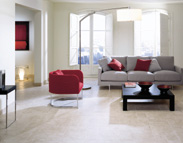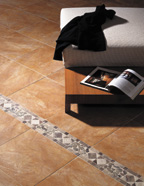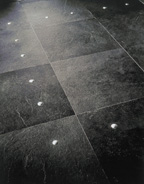
Cersaie, the world’s largest exhibition of ceramic tile and bathroom furnishings, celebrated its 20th anniversary Oct. 1-6, 2002. More than 100,000 attendees gathered at the massive show in Bologna, Italy to see the latest in Ceramic designs from 1,060 exhibitors representing more than 30 countries.
Cersaie is where the latest ceramic products are unveiled and design trends set for the coming year. Just as repeat attendees of the show have come to expect, new trends in color, format, technology, and style commanded center stage throughout the event’s duration.

Cementitious & industrial looks
The new neutrals in tile were inspired by soft cements -- a trend that was first previewed by the Italians at Coverings 2002. At Cersaie, however, Italian producers showed variations on the theme with mottled grays, and swirling muted black-and-cream finishes. These down-to-earth, industrial looks -- often punctuated with metallic inserts -- would look equally at home in an urban loft, stainless-steel kitchen or commercial installation. Large sizes seem to be the popular format for this look.
Some of the best cement looks were: Edilgres Cementi, Cotto D’Este Instyle Grey, Atlas Concorde Concrete, Rex Pillarguri, Magica Inspired, Century Sector, and Lea Stonehenge. Three producers -- Marca Corona, ABK-Gres and Valverde -- each had cement-look products called Loft.
Bold, bright colors
The fair was alive with color -- bold, bright and clear. Vivid orange, green, yellow, and blue were seen at exhibits throughout the show. Textured, cut-out, in large and small formats, color made its presence known. Mosaics were the most popular format for color. Comic book pop art was produced in large-scale mosaic panels showcased by SICIS. At the Ceramgres exhibit, vibrant color seemed to melt down the wall in the large glass slabs that make up the Vitrum Liqua series. Bisazza, Appiani, Trend, and Cerasarda were just a few of the companies that portrayed color as king.Dom Naturalia, designed by Giorgio Vigna, featured bright bold colors, scooped edges and textured dot-pattern surfaces, bringing together several of the current trends in one eye-catching line.
At Cotto Veneto, designers created Vetro Echi D’Oriente, a series of glass tiles that cover splashes of paint. The result was unique and colorful.
Bardelli, one of Italy’s leading wall tile producers, introduced a new and updated color system called “Colore & Colore” and “Reflessi & Reflessi.” The colorways were split into nine color families, 36 different colors and two different finishes that are all compatible. The line includes tiles for the floor and wall. Bardelli’s sister company Gabbinelli showed Astratto, a bold new series of wall tiles designed by Mario Piazza.
Ascot introduced a clever new series called Pun. The chunky subway-style tiles were shown in aquamarine, orange, blue, brown, and white, and featured bas-relief lettering that can be customized.
Marca Corona showed Glossy, a new line of glass glazed mosaic strips, while at Maestri Maiolicari, hand-shaped Odissea and Astratto were alive with color and texture. In balance to this outburst of color, grays and blacks were positioned as the new neutrals.

Design revival
Back in the 1960s and ’70s, it was the Italians who pushed industrial design to new heights. Many of the decorative motifs on display at Cersaie 2002 were a playful homage to that period.Marazzi called on fashion designers at Benetton to create a new line entitled Joy, which featured colorful green, orange and yellow patterns inspired by the 1970s.
Verner Panton Op Art fabric of 1961 seemed to be the inspiration for several white and black circular patterns: Naxos Trend, Cogir Glass 70s and Dado Bolle. Lea introduced the unusual Progetto 14 Lounge Collection series of sculpted bas-relief tiles that bring to mind a Ferrari car-body. Dom Vintage featured melting bas-relief-like patterns in soft tones, while Cerdomus showed the colorfully retro Optical.
Tactile pleasures
Many of the tiles on display at Cersaie begged to be touched, as producers again mixed textures. Textural effects like linen, moss, leather, gravel, bark, wood, sisal, florals, pebbles, dots, circles, and metals were all mixed with porcelain, monocottura or terracotta fields to add dimension. Cotto Veneto added to its extensive collection of textural finishes with Stuoie, a new line of textured terracotta motifs that have the look of nubbly linen or knitware. Arkadia showed Avanguardia, a line of mesh-mounted porcelains that look and feel like aged, tumbled pebbles.
Grazie showed Boiserie, a new ceramic that had the look and texture of traditional American bead board.

Cut up
This year, inserts really cut loose. There were circular inserts, slices cut out of field tiles, squares within squares, and asymmetrical strips. One new company, Brix, took this idea a step further. Under the auspices of their Degre Program, Brix invited three designers to take their new line of porcelain tiles and cut or finish them to create a new look. The results were innovative and surprising.Cut-out inserts were seen in Atlas Concorde’s Contemporary, where designers mixed glass, wood and metal inserts to stunning effect. Other noteworthy examples were Marca Corona Openspace, Rex Pillarguri, ABK-Gres Cocco, and Ascot Forge.
The trend in earthy metallics continues to shine as more manufacturers showed metal inserts of every size and shape. Geometric metallic accents were paired with cool coal-gray porcelains in Refin Avantguarde. In Cotto Veneto’s Acciaio, curves wended their way through stone and porcelain fields. Ascot’s Splash featured a watery wave effect, which was echoed in a pencil-thin curvilinear metallic trim. Blacks and whites were mixed to add contrast in ABK Gres’s In Cava porcelain marbles, while Settecento’s Palazzo Dei Normanni mixed metallic trims with warm terracotta fields. Other metallic highlights included Gambarelli’s unusual Avalon, SICIS Metallismo mosaics, and Trend’s shimmering metallic mosaics.
Rectangular formats a favorite
The rectangular format continues to be a particular favorite. This year, it was elongated, mesh-mounted and blown-up in size -- all to dazzling effect. Many exhibitors showed new modular rectangles which were mixed with squares, circles and cut-out geometrics.
Brix Nils featured architectural grids of thin rectangular shapes. Ceramica Di Treviso showed Totum, an all-in-one wall-mounted sink tile piece, designed by Roberto Pezzetti. The Totum line also features miniature rectangular tile/mosaics. Other highlights included Senio’s Arte Nouveau, Pastorelli’s Castelmonte and Cerdomus’ Pietro Di Assisi.
Porcelains more popular
The appetite for elegant stone looks has spurred an ever-expanding array of cost-effective, elegant and low-maintenance porcelain options. In fact, during 2001, 308.7 million square meters of porcelain tile produced in Italy. That was a 15 percent increase from the year before. Consistently improving on the technology, manufacturers increasingly are offering their new lines with rectified edges.Tagina was inspired by multi-hued Santa Cruz stone from Bolivia to create the stunning Santa Cruz series. Eco Ceramica mastered the look of tumbled marble with the new Marmaron series. San Prospero presented Colorado, a versatile slate look created in porcelain. Monocibec Century’s Arte Del Marmo rosette is styled to add age-old elegance to any setting. Panaria showed Rocky Mountain, a line created with soft rectangle formats, while Piemme showed Terra de Fuoco, a glazed porcelain line with the feel and look of rough-hewn stone.
Although Cersaie is a showcase for Italian manufacturers, exhibitors from more than 30 countries around the world also were on hand to exhibit their newest designs. Largest among these countries was Spain. With 97 of that country’s top manufacturers present, Spain represented nearly 50 percent of non-Italian exhibitors at Cersaie.
Spanish porcelain products shown at Cersaie incorporated several technical innovations, including integral design, which replicates the full-body veining found in natural stone, as well as double-press technology and silicone rolling screens that allow for design patterns to be applied to the low relief areas of textured surfaces.
Dominant Spanish stylistic trends at Cersaie included the prevalence of rustics, which have become more refined and sophisticated, mosaics and mosaic imitations, which appeared in tumbled or polished marble antique imitations, as well as glass-like finishes in a variety of colors. Metallic and glass accents remained popular, as did textural finishes and large formats. Many Spanish manufacturers -- including Alcalagres, Ceracasa, Colorker, Roca, Rocersa, Alaplana, Gres Catalan, Keraben, and Sanchis -- introduced new product lines.
Cersaie 2002 continued the show’s 20th year very successfully, providing the first look at the ceramic products that will set the stylistic trends for the coming year.
Editor's note: Much of the material presented in this story was based on trend analyses provided by Christine Abbate of Novita Publications and Inma Roca of Inma Roca Associates.
Report Abusive Comment